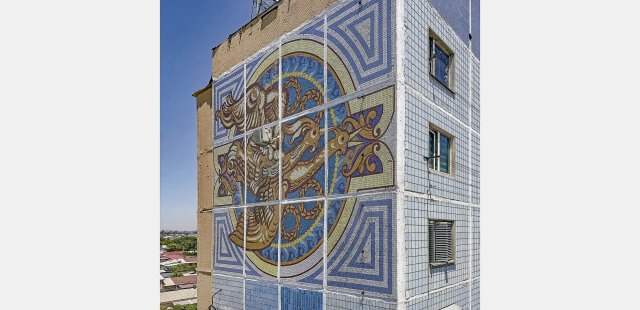Mosaic on the facade of a building in Tashkent, by Alexander Jarsky, 1985
Photo: © Philipp Meuser
The best place to create something new, beautiful and useful is where there is a lot of construction going on. And Tashkent was such a city back then.” This is how Nikolai Jarsky explained his decision to move to the capital of the Uzbek Soviet Republic with his two brothers, according to the new illustrated book “Facade art in prefabricated buildings” by Philipp Meuser.
The artist trio Nikolai, Pyotr and Alexander arrived shortly after an earthquake in April 1966 destroyed large parts of the city. The other Soviet republics provided generous emergency aid, and reconstruction progressed quickly. The brothers immediately began implementing their ideas for the facade design of the new housing developments that were being built everywhere. Over the next few decades they covered the city with a variety of colorful mosaics. The brothers often resorted to the most beautiful ornaments from Islamic art and combined them with motifs that came from their fascination with space travel: cosmonauts, rockets and satellites. At one place in the street, such examples of Soviet euphoria for the future and enthusiasm for technology are suddenly replaced by an oversized portrait of the Uzbek national hero Zahir ad-Din Muhammad Babur – executed by Pyotr Jarsky. The largest mosaics decorate the entire gables of nine-story apartment blocks. And even today, passers-by can see for themselves how the brothers, with their vision, managed to combine art and architecture in an impressive way. According to Meuser, they developed a completely new technique for facade design: With the so-called Jarsky method, the parts for the huge mosaics are designed in the cement factory, poured into the individual concrete slabs and assembled on the construction site. From the beginning, the architectural decoration is integrated into the concrete elements. The motif, the material and the building become one.
nd.Kompakt – our daily newsletter

Our daily newsletter nd.Compact brings order to the news madness. Every day you will receive an overview of the most exciting stories from the world editorial staff. Get your free subscription here.
But the experiments in the design of facades were not limited to mosaics. In many places the brothers created finely crafted pieces Pandscharas – a kind of grid to protect against the strong Uzbek sun. This architectural detail often creates an enticing play of light and shadow over the buildings, breaking their otherwise austere expression. Through the repetition of patterns in elaborately cast concrete and the surprising arrangement of facade elements such as balconies, window frames and entrances, the Soviet citizens’ new houses became complete works of art. Aesthetics and lived life mixed. The boundary between artistic representation and reality faded.
Due to the size of the works and their often prominent location in the cityscape, the Jarsky brothers’ mosaics were particularly suitable for propaganda in favor of the regime and the socialist social model. The control of such expressive facade designs could not be left to anyone other than the most powerful man in the republic:
“The then First Secretary of the Central Committee of the Communist Party of Uzbekistan, Sharaf R. Rashidov, inspected the decorated panels at the combine and approved them for use on the construction site,” wrote Nikolai Jarsky in his 2003 memoirs.
The motifs mostly correspond to the requirements of socialist realism: clearly figurative, easy to read and convey a positive view of life in the USSR. In addition, the regime welcomed the Jarsky brothers’ experimentation with oriental patterns as a laudable attempt to further develop an independent national formal language for Uzbekistan.
But over the years the motifs become detached from purely political content. The center of power, Moscow, was many thousands of kilometers away. In fact, Uzbekistan had extensive autonomy compared to other republics of the USSR. That may have helped expand the playing field for the Jarsky brothers, according to Meuser.
The inspiration from the traditional art of Uzbekistan – which is often non-figurative due to the widespread ban in Islam on the depiction of people and animals – gives rise to increasingly abstract and apolitical works characterized by geometric figures and compositions. A particularly large number were created along residential facades in Tashkent in the 1980s. This development and breadth of motifs and artistic styles testify to the Jarsky brothers’ diverse talent and to the fact that they largely managed to work independently and with integrity despite the political conditions.
However, from today’s perspective, the quality of the building materials does not always do justice to the brothers’ high artistic level. The condition of many buildings sometimes leaves something to be desired.
“Today, of course, I look with some sadness at the partly run-down residential buildings that were built with so much enthusiasm back then. Unfortunately, the days of the construction industry boom, friendly collectives and committed administration are over. The collective idea of making Tashkent an unforgettably beautiful city remains a memory,” wrote Nikolai Jarsky in his memoirs a few years after the collapse of the Soviet Union.
Given Khrushchev’s extremely cost-efficient series construction, the two percent of the expenses that the Jarsky brothers spent on facade decoration was still a small triumph. Proof of what social commitment and individual creativity can achieve, as Meuser emphasizes.
Philipp Meuser: Facade art in prefabricated buildings: The work of the Jarsky brothers in Soviet Tashkent. 368 pages and 540 illustrations, hardcover, €48.
